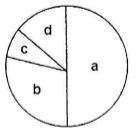 Multiple Choice Questions
Multiple Choice QuestionsThe figure below shows the nervous system of Mollusca with ganglia and the connecting nerves. The connecting nerves are labelled as A, B, C and D.

Which one of the following options has correct labelling of A, B, C and D?
A-Cerebral commissure; B-Left Cerebropedal connective; C-Pedal commissure; D-Left Pedal-visceral connective
A-Cerebral connective; B-Left Cerebropedal commissure; C-Pedal connective; D-Left Pedal-visceral commissure
A-Occipital commissure; B-Occipito-pedal connective; C-Pedal commissure; D-Left Pedo-caudal connective
A-Cerebral connective; B-Left Cerebropedal commissure; C-Pedal commissure; D-Pedal-caudal connective
A.
A-Cerebral commissure; B-Left Cerebropedal connective; C-Pedal commissure; D-Left Pedal-visceral connective
Following are certain statements regarding energy efficiencies of ectotherms and endotherms:
(a) Ectotherms have high assimilation efficiency but low production efficiency.
(b) Ectotherms have low assimilation efficiency but high production efficiency.
(c) Endotherms have high assimilation efficiency but low production efficiency.
(d) Endotherms have low assimilation efficiency but high production efficiency.
Which one of the following represents the combination of correct statements?
(a) and (b)
(b) and (c)
(c) and (d)
(a) and (c)
Given below are some properties related to botanical and zoological nomenclature.
(a) Absence of tautonyms
(b) Presence of genus and species ranks only
(c) Absence of principle of coordination
(d) Presence of only holotype and neotype
Select the correct combination that distinguishes botanical nomenclature from zoological nomenclature system.
(a), (b) and (d)
(a), (b) and (c)
(a) and (c) only
(a), (c) and (d)
Following table gives a list of international environmental agreements and areas covered. Which one of the following is the correct combination?
| Agreement | Area Control |
| (a) Basel convention | (i) Biosafety |
| (b) Cartagena protocol | (ii) Control of trans-boundary movement of hazardous waste and their disposal |
| (c) Kyoto protocol | (iii) Green house gas emission reduction |
| (d) Stockhlom Convention | (iv) Presistent organic pollutants |
| (a) | (b) | (c) | (d) |
| (i) | (ii) | (iv) | (iii) |
| (a) | (b) | (c) | (d) |
| (ii) | (i) | (iii) | (iv) |
| (a) | (b) | (c) | (d) |
| (iv) | (i) | (iii) | (ii) |
| (a) | (b) | (c) | (d) |
| (ii) | (iv) | (iii) | (i) |
The following figure is a “risk-graph” that illustrates the percent risk a species faces towards extinction

The following are ranks assigned according to IUCN’s red-list category:
(i) Critically endangered
(ii) Near threatened
(iii) Vulnerable
(iv) Least concern
Which of the following is the most appropirate match between the percent risk and their assigned rank?
| (a) | (b) | (c) | (d) |
| (i) | (iii) | (iv) | (ii) |
| (a) | (b) | (c) | (d) |
| (i) | (iv) | (iii) | (ii) |
| (a) | (b) | (c) | (d) |
| (iii) | (ii) | (iv) | (i) |
| (a) | (b) | (c) | (d) |
| (iv) | (iii) | (ii) | (i) |
